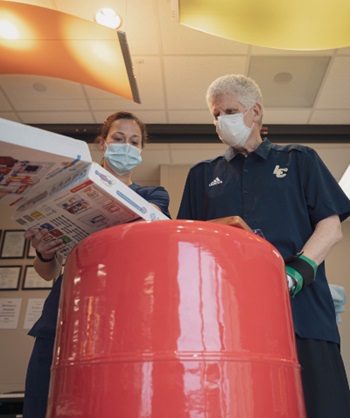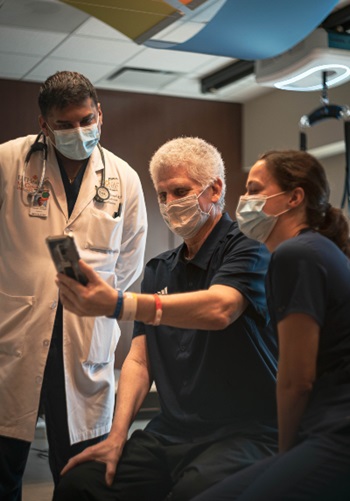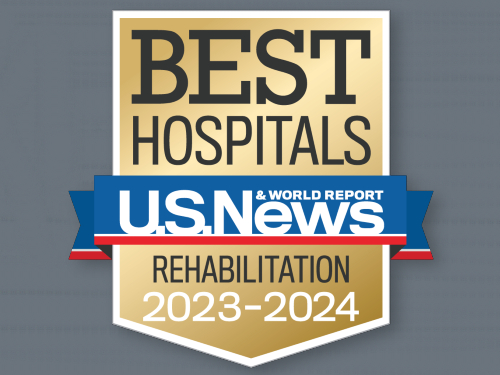As a high school principal, Phil Eaton is constantly on the go… football games, staff meetings, and other activities fill his calendar. In March 2020, he was admitted to Memorial Hermann The Woodlands Medical Center with pneumonia. A short time later, he was diagnosed with COVID-19.
His condition became serious, and he spent 21 days on a ventilator.
After being discharged from acute care, Phil was extremely weak and demonstrated some changes in his memory and ability to process and organize is thoughts. To further his recovery, his healthcare team recommended he transition to inpatient rehabilitation at TIRR Memorial Hermann The Woodlands Medical Center ("TIRR") for customized rehabilitation for patients who have recovered from COVID-19.
“You’ve got to be so careful with this virus,” said Phil, who was hospitalized for a total of 51 days. “I am so thankful for TIRR and the Memorial Hermann Health System.”
He survived the virus – however, he had a long way to go to get back to his former self.

“In conditions like COVID-19, the patient has had a significant change in their functional status or their ability to move around and do their daily activities,” said Dr. Jacob P. Joseph, Physical Medicine and Rehab (PM&R) Specialist and Phil’s attending physician at TIRR. “Patients also could experience difficulty with their cognition and could benefit from coming to inpatient rehabilitation directly from acute care.”
Once admitted to inpatient rehabilitation, patients are assigned an experienced, specialized rehabilitation team consisting of the attending physician, nursing staff, therapists, neuropsychology and other professionals who are all working together to get the patient as close to their previous level of function as possible.
“With COVID-19, we’re still learning every day about new ways that patients are affected in addition to the respiratory problems,” said Dr. Joseph. “When the body is in a stressed state, it can attack its own nerves and muscles, creating neuropathy or myopathy which can really slow down someone’s recovery from a physical standpoint.”
Additionally, being on multiple medications and variable oxygention can result in cognitive deficits.
“When he initially arrived he was having some memory problems, and it was challenging for him to stay on topic when we were talking. Phil’s thoughts weren’t organized – he did a lot of jumping around. For his profession, we knew that would be a problem and began addressing those issues,” said his speech language therapist Nicole Wren, MA, CCC-SLP.
Nicole incorporated tasks that could relate to Phil’s work as part of his therapy. For example, she had him plan out a morning school announcement given a list of criteria and then practice saying his announcement out loud. He also wanted to write thank-you letters, so she used this as a treatment task that targeted each of his speech therapy goals - organization, planning, and attention.

“Initially, he would need a 5 or 10 minute break when simply going from sitting to standing,” said Claire. “We took really small steps because he needed to conserve his breath and energy. It was a big day when he was able to walk to the bathroom and later down the hallway. He made weekly advancements and ultimately was able to walk 1000 feet.”
While walking down the halls, Claire would put people and obstacles in his path to simulate what it would be like for him to walk down the hallways of his school when he returned to work. She also helped him prepare to go home by building his endurance so that he could go up and down the stairs in his home.
“He was a good sport,” said Claire, “He had some pain in his foot due to neuropathy so we had to overcome that challenge. But he worked really hard.”
One of the first things his occupational therapist, Katie Pecot, OTR, did was learn what Phil liked to do away from his job.
“He enjoys golfing and basketball, so we used that as part of his therapy to build muscle mass/strength, endurance, respiratory capacity, and high-level cognition,” said Katie. “I spent sessions focused on standing tolerance and functional endurance while typing, playing basketball, shaving, managing clothes and engaging in games that involved problem solving.”
When he was leaving TIRR to go home, the community and Memorial Hermann The Woodlands Medical Center held a parade in front of the hospital to celebrate the beloved principal’s recovery. He will continue his recovery as a TIRR outpatient.
“They have been so good to me,” said Phil as he was leaving TIRR. ”I feel great. I can stand, walk and even dance! Their dedication to their jobs, professionalism, kindness and ability to meet me where I was (which was not very good) makes me want to cry!”

Nationally Ranked Rehabilitation
For the 34th consecutive year, TIRR Memorial Hermann is recognized as the best rehabilitation hospital in Texas and No. 4 in the nation according to U.S. News and World Report's "Best Rehabilitation Hospitals" in America.
Learn More